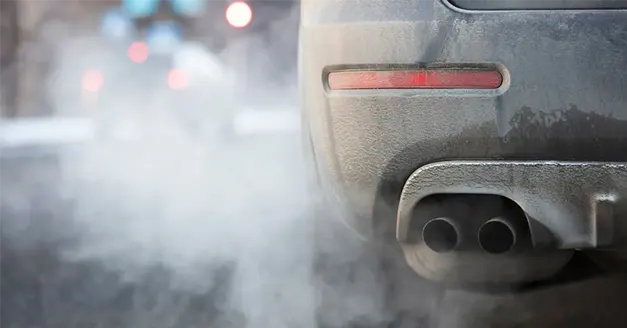
The Golden State — California — is a cultural melting pot, a land of many geographical wonders, and the home to one of the world’s leading climate change reduction advocates, CARB. CARB emissions reduction legislation has been a gamechanger for our planet.
CARB? Yes, the California Air Resource Board (CARB). If you’re an original equipment manufacturer (OEM) or business that regularly deals with vehicle emissions and monitoring, CARB is crucial to keeping your business in compliance and profitable.
Why?
Because CARB, among other organizations, plays an enormous role in determining nationwide legislation and compliance standards for acceptable vehicle emissions rates produced by newly developed and emerging vehicle prototypes.
If you’re curious to learn about CARB’s role in your business or industrial operation’s success, we invite you to continue reading on.
GlobalMRV here: having worked in environmental compliance, specifically with vehicle emissions monitoring and reporting, for more than 20 years, we wrote this article to provide you with more clarity about CARB and its impact on your operation.
In this article, we’ll discuss:
- What the acronym, CARB, stands for
- CARB’s role in air pollution reduction
- The goals of CARB (and how they can influence businesses nationwide)
- The successful impact CARB has made on our world’s climate change-fighting institutions
- CARB and the importance of decreasing smog and developing air pollution regulations
- How CARB has influenced legislation aimed at reducing vehicle emissions nationwide
- What GlobalMRV has to do with CARB and businesses nationwide
- Frequently asked questions (FAQ) about the California Air Review Board
What CARB stands for

CARB stands for California Air Resources Board. And what does CARB stand for, mission-wise?
As stated on their website, part of CARB’s mission is “to promote and protect public health, welfare, and ecological resources through effective reduction of air pollutants while recognizing and considering effects on the economy.”
As such, the California Resources Board helps protect the environment and support California’s economy by creating new programs and suggested legislation for other organizations that are interested in reducing emissions that contribute to air pollution. CARB is often seen as an important player in California’s air pollution mitigation strategy in tandem with the U.S. Clean Air Act (CAA).
The relationship between CARB and air pollution reduction rules

Now that we’ve discussed CARB’s role in reducing air pollution, what is their relationship to air pollution reduction rules and legislation? CARB’s responsibilities include the following:
- Creating regulations for vehicles to prevent excessive emissions
- Developing new and creative solutions to decrease the amount of greenhouse gases contributing to air pollution
- Developing plans to work towards a zero-emissions future
Part of CARB’s work in ensuring zero emissions in California, includes:
- Incentivizing the use of electric vehicles and zero-emission vehicles (ZEVs) for buses and trucks
- Requiring drayage trucks entering seaports and railyards to be zero-emission by 2035 (though recent legislation may affect this goal).
- Advocating for more research and development into zero-emission trucks to support reducing statewide emissions and exposure to toxic air pollutants.
In essence, CARB is one of the leading world organizations advocating for cleaner air standards and legislative reforms across the state. Many other states — and even countries — take after CARB’s example.
What’s more, CARB also keeps one eye on the economy as CARB advocates for reforms. For example, CARB is one of the leading proponents of air pollution regulation in California.
At the end of the day, CARB’s goal is to ensure the safety, health, and well-being of residents and ecological resources in California by advocating for reforms aimed at reducing air pollution and environmental degradation.
CARB’s goals are…

While one of the main goals of CARB is to help develop measures for other organizations working towards mitigating climate change, CARB’s main goal is to decrease air pollution and protect local communities from air pollution’s harmful effects.
In other words, the public’s health is always top-of-mind for CARB. California lawmakers often look to CARB as a precedent for future environmental law-making.
CARB’s main responsibilities include:
- Setting air quality standards: for organizations across California. CARB will often set standards with the state’s most vulnerable populations in mind, for example, the elderly or people suffering from respiratory diseases.
- Determining threats: CARB will assess to what degree pollutants pose a threat to residents and the economy.
- Measuring and monitoring environmental programs: to determine the success of environmental programs’ efforts to mitigate pollution.
- Improve air quality: for California residents.
- Act as compliance agents: CARB ensures automakers adhere to environmental regulations.
- Research and development: of new technologies that can help reduce air pollution.
- Guide California’s lawmakers: in creating goals, energy-efficient measures, and emissions reduction legislation where possible.
- Environmental advocacy and education: CARB raises awareness of the importance of air quality controls, such as hydrocarbon emission controls.
The California Air Resource Board will often hold meetings each month to review progress toward making California’s air quality cleaner and healthier. During these meetings, CARB will review how decisions can help benefit everyone involved, including businesses and local communities.
Finally, one of CARB’s main goals is to help develop special programs for neighborhoods impacted by air congestion, or areas with heavy traffic. For example, CARB is dedicated to serving communities and neighborhoods located near highways, ports, shipping yards, railways, and industrial manufacturing plants so that these communities stay healthy and well.
Successful changes led by the California Air Resources Board (CARB)

Lest we overstate the importance of CARB, their successes speak for themselves. CARB has been in operation for more than 50 years.
Their origins trace back to the 1960s when several California state leaders expressed how essential improving air quality across the state was for the state’s well-being.
Fortunately, CARB was created to help navigate air pollution from internal combustion engine vehicles, transport refrigeration units, and other air pollution-emitting vehicles in California.
CARB’s successes include the following:
- Reducing the amount of toxic air pollutants created by internal combustion engine vehicles by 99% from the 1970s
- Driving innovation to catalytic converters, which helped slash ozone by 60%
- Playing a pivotal role in the development of the Global Warming Solutions Act (GWSA) of 2006
- Playing a key role in helping pass environmental laws — such as SB 32 in 2024 and AB 393 in 2017 — and mapping out how California can reduce greenhouse gases in the future
Most of CARB’s successes can be traced back to helping decrease smog and spearheading the creation of emissions regulations. Let’s explore more about each in the following two sections.
CARB emissions regulations: decreasing vehicle smog and air pollution

Speaking of smog and air pollution, one of CARB’s greatest impacts is the development of the catalytic converter, which has helped create cleaner fuels and produce lower emissions for vehicles.
CARB has also helped with cap-and-trade programs and low-emission programs for zero-emission vehicles (ZEVs), such as the Low Carbon Fuel Standard. Per their website, CARB’s ultimate goal is to “reduce greenhouse gases 80 percent below 1990 levels by 2050.”
Though this goal may be ambitious, with the help of their partners monitoring and reporting vehicle emissions, CARB’s sustainability goals may be closer than we think to becoming a reality.
CARB compliance: CARB’s role in implementing U.S. emissions-based legislation

While CARB has also helped companies with implementing necessary regulations for supporting emissions reductions, CARB has also collaborated on new regulations and compliance requirements aimed at curbing greenhouse gas emissions in the transportation sector and in the manufacturing industry.
In fact, CARB’s help with the Global Warming Solutions Act (GWSA) influenced states like Vermont and Massachusetts to draft pollution control mandates and their own climate change acts.
What’s more, CARB stands at the forefront of vehicle emissions reduction. In September 2023, California legislators enacted more stringent legislation that would ban residents from buying cars powered by gasoline starting in 2035.
The same legislation — influenced by CARB — also called upon improving the state’s public transportation system, though recent legislation by the Trump administration may affect the passage of said legislation.
Finally, CARB has also played a key role in ensuring climate bills would be introduced that require businesses to be more transparent about their greenhouse gas emissions output.
As climate legislation continues to be proposed, passed, challenged, and changed, CARB will become even more important in the fight for creating a healthier, cleaner environment the world over.
Did you know?
Did you know that tools exist to measure the emissions profile of internal combustion engine-powered vehicles like Jeeps and ATVs?
Portable emissions measurement systems (PEMS) give you the power to test emissions at your fingertips. These 2 feet by 2 feet industrial-strength emission devices give you real-time data that’s needed to create cleaner, healthier products.
You have to see it to believe it.
At GlobalMRV, we took our PEMS devices out into the steep and rocky Allegheny National Forest to test the emissions output of 4×4 Jeeps in rugged conditions. You can see our 11-hour journey of continuous emissions monitoring of more than 60 different testing regimes here on our Instagram page.
GlobalMRV’s relationship with CARB

A recent dataset suggests that California emits on average 300-400 million metric tons of CO₂ in any given year (Federal Reserve Economic Data (FRED), 2023). As such, keeping tabs on vehicle emissions will play a larger role as new technologies develop.
With that being said, CARB’s advanced clean air legislation can only be enacted with the help of organizations and trusted partners dedicated to decreasing vehicle emissions and fighting to create a cleaner, greener world.
CARB relies on partners like us to provide trusted tools that are needed to help CARB fulfill its mission of creating a cleaner world. So, what does supporting CARB look like in action?
Cue GlobalMRV.
Our portable emissions measurement systems (PEMS) and PEMS accessories were designed to help CARB, original equipment manufacturers (OEMs), and industrial operations teams create internal combustion engine-based vehicles that emit fewer and less harmful pollutants into the air.
With PEMS, we can run more than 60 different types of diagnostic testing regimes and support over 100 different vehicles and engines for overall emissions reduction and fuel calibration testing. As part of the fight to create cleaner air, our PEMS and PEMS accessories can help with the following:
- Key air pollutants — such as CO, CO₂, NO, HC, O₂ — emitted from the tailpipes of ICE-based vehicles
- Particle mass and particle number measurements
- Assessing pollutants trapped and added into the water table near roadways
- And more!
If you’re in the business of making our environment cleaner by measuring, reporting, verifying, and/or reducing emissions, we can help. For more information about our sustainability consulting services or emissions monitoring products, we invite you to contact us today.
Frequently asked questions (FAQ) about CARB

1. Has CARB worked with other companies to implement climate legislation?
Yes! CARB’s partners include:
- California Energy Commission
- Local utility companies
- CalStart
- The Governor’s Office of Business and Economic Development (GO-Biz)
- Multi-state zero-emission vehicle (ZEV) task forces
- Local entities and businesses
2. Has CARB been successful at reducing air pollution?
They sure have. CARB has influenced the development of new technologies, such as catalytic converters, which have been pivotal in creating cleaner fuels and lower-emission vehicles.
CARB also sets the standard for acceptable limits for many diesel-powered heavy-duty vehicles.
3. What challenges does the California Air Resource Board face?
Global-warming-induced natural disasters — such as droughts, wildfires, rising sea levels, and poor air quality — coupled with burning fossil fuels for energy use, industrial activities, agricultural production, deforestation, and transportation pose challenges to CARB as CARB attempts to reduce the harmful effects of air pollution.
What’s more, the weaponization and rejection of peer-reviewed scientific research and evidence by select policymakers may potentially affect CARB’s goals of creating a cleaner and greener world.
With that being said, CARB’s track record and history of success suggest that they’re more than up for the task of meeting each and every challenge — just as they have for the last 50-plus years since their inception.
GlobalMRV: Driving the Future of Emissions Testing with Real-Time Data Solutions